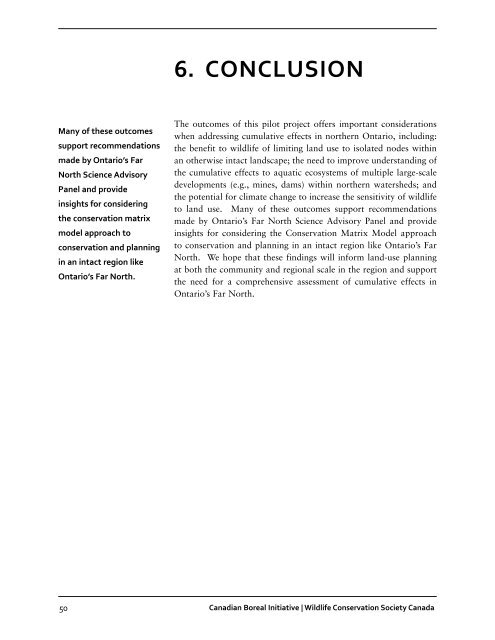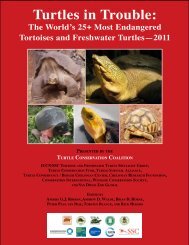Create successful ePaper yourself
Turn your PDF publications into a flip-book with our unique Google optimized e-Paper software.
6. Conclusion<br />
Many of these outcomes<br />
support recommendations<br />
made by Ontario’s Far<br />
North Science Advisory<br />
Panel and provide<br />
insights for considering<br />
the conservation matrix<br />
model approach to<br />
conservation and planning<br />
in an intact region like<br />
Ontario’s Far North.<br />
The outcomes of this pilot project offers important considerations<br />
when addressing cumulative effects in northern Ontario, including:<br />
the benefit to wildlife of limiting land use to isolated nodes within<br />
an otherwise intact landscape; the need to improve understanding of<br />
the cumulative effects to aquatic ecosystems of multiple large-scale<br />
developments (e.g., mines, dams) within northern watersheds; and<br />
the potential for climate change to increase the sensitivity of wildlife<br />
to land use. Many of these outcomes support recommendations<br />
made by Ontario’s Far North Science Advisory Panel and provide<br />
insights for considering the Conservation Matrix Model approach<br />
to conservation and planning in an intact region like Ontario’s Far<br />
North. We hope that these findings will inform land-use planning<br />
at both the community and regional scale in the region and support<br />
the need for a comprehensive assessment of cumulative effects in<br />
Ontario’s Far North.<br />
50 Canadian Boreal Initiative | Wildlife Conservation Society <strong>Canada</strong>







![RaLand / SeaScape [PDF] - Wildlife Conservation Society](https://img.yumpu.com/49974326/1/190x245/raland-seascape-pdf-wildlife-conservation-society.jpg?quality=85)









